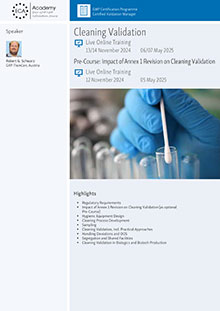FDA'S NEW REQUIREMENTS ON PROCESS VALIDATION - AN OUTLOOK ON THE NEW FDA GUIDANCE
At the PAT Conference 2008, which was organised jointly by the University of Heidelberg and the European Compliance Academy (ECA), Jon Clark from the FDA gave an outlook on the upcoming new FDA Process Validation Guidance. The new Guidance will replace the current version of 1987.
The new approach of Process Validation considers validation as a series of activities taking place over the "life" of a product or process. Its key goal is hence to achieve process understanding. As a consequence the overall validation is not "complete" but ongoing. It requires a comprehensive process design to identify and mitigate significant sources of variability. The Process Validation may also incorporate risk management and recognises that more knowledge will be gained during commercial distribution. This is a fundamental change from the traditional three batches validation. In his presentation Jon Clark mentioned that the life cycle approach to Process Validation consists of three elements:
Process Design
Process Qualification and
Continued Process Verification
Process Design assures that the commercial process is defined based on knowledge gained through development and scale-up activities. Process Qualification consists of two aspects: Design of facilities including qualification of equipment and utilities and performance qualification. During his talk he defined the criteria for the Performance Qualification Protocol. This document specifies the manufacturing conditions, controls, testing and the expected outcomes. It should therefore include operating parameters, processing limits and component (raw material) inputs, the data to be collected and when and how these data have been evaluated. In addition the Protocol should include the test to be performed (in-process, release and characterisation) and acceptance criteria for each significant process step. Also the sampling plan including the sampling points, number of samples and the frequency of sampling for each unit operation and attribute needs to be considered. He emphasised that the number of samples should be adequate to provide sufficient statistical confidence of both within a batch and between batches. As further components of the Performance Qualification Protocol he noted:

Recommendation
Wednesday, 7 May 2025 9 .00 - 12.30 h
Post-Course: Impact of Annex 1 Revision on Cleaning Validation - Live Online Training
- Criteria that provide for a rational conclusion whether the process consistently produces quality products
- Design of facilities and the qualification of utilities and equipment, personnel training and qualification and verification of material sources
- Status of the validation of analytical methods used
- Review and approval by appropriate departments and the quality unit
Part II of this article you can find in the Internet at www.gmp-journal.com.
Author:
Oliver Schmidt
CONCEPT HEIDELBERG



